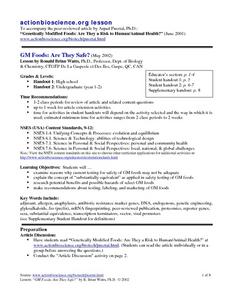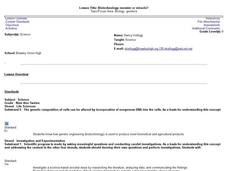Curated OER
Edible GMOs?
The debate over genetically modified organisms is on! Young biologists imagine that they have been asked to choose which corn chips will be sold for a fundraiser, one made with GMOs or one without. This four-day lesson plan requires...
Curated OER
Genetically Modified Foods
High schoolers explain what genetically modified foods are and how they are created. Students use appropriate vocabulary to describe and effectively discuss the benefits of, and potential risks of, genetically modified foods.
Curated OER
GM Foods: Are They Safe?
Students examine the process for testing GM foods. They research benefits and hazards of a selection of GM foods. They also create images of new labels and marketing for GM foods.
Curated OER
DNA: The Human Body Recipe
Students describe DNA and the roles in which engineers are involved with the human body. For this DNA lesson students participate in a class demonstration.
Teach Engineering
DNA Forensics and Color Pigments
Use food coloring in electrophoresis. The last segment in a four-part series mimics DNA fingerprinting by using chromatography. Teams conduct chromatography on food coloring to find colors that use similar pigmentation in their makeup.
Curated OER
Genetically Modified Foods in Perspective
Students research the concept of genetically modified foods. The purpose of the research is to increase science content knowledge and comprehension of the controversy surrounding the subject.
Curated OER
Biotechnology: Monster or Miracle
Students explore biotechnology. For this scenario-based lesson, students take a survey on what they know about genetic engineering, view a PowerPoint, and conduct a web quest. Students will then be placed in groups, and produce one of...
Curated OER
Genetic Engineering
Students will apply their knowledge acquired from two guest speakers to writing a three hundred-word essay on either the pros or cons of genetic engineering. They will try to persuade the reader of their essays to agree with their stance...
Curated OER
Peanut Butter Broccoli
Fifth graders explore food production by viewing DNA presentations. In this genetic engineering lesson, 5th graders discuss the foods they typically eat at home and how many common foods are engineered in a way that can produce a bigger...
Curated OER
Genes: The Building Blocks of Life
Students examine various topics on genetics. Students explore the Internet to gather information on genetic testing, genetically engineered food, forensics, DNA and cloning. They research and determine the best way to fund each of the...
Curated OER
Biology Trivia Questions
Students answer 71 questions about a variety of topics in biology. In this biology trivia lesson plan, students use the internet to find the answer to questions about the systems of the body, their structures and functions, the different...
Curated OER
High Tech Food
Learners view videos, read, and fill in charts about agriculture production. For this agriculture lesson plan, students complete these agriculture activities and explore careers in agriculture.
College Board
2014 AP® Biology Free-Response Questions
The most popular AP science exam, Biology, also maintains the highest passing rate. The College Board releases old test questions covering trichomes and much more, along with statistics and scoring guidelines to help scholars study for...
Chicago Botanic Garden
Calculating Your Carbon Footprint
Unplugging from technology for one day per week will decrease your carbon footprint—are you up to the challenge? Part two in a series of three allows individuals to explore their personal carbon footprints. By first taking a quiz at home...
Chicago Botanic Garden
Calculating Your Ecological Footprint
You can lower your ecological footprint by recycling! Lesson four in this series of five has individuals, through the use of a computer, calculate their ecological footprints. Through discussions and analysis they determine how many...
Curated OER
Plant Science Introduction
A unique PowerPoint explains the basics of plant science. It motivates viewers to study plant science and then lists different food products, biofuels, fibers, timber, and ornamental uses of plants. It concludes with lists of careers...
Curated OER
Genetic Decision Making Model
Students examine case studies involving bioethics. They write a paragraph explaining the problem. Students construct a list of values that are involved in the conflict. They list probable solutions to the problem and consequences to...
Curated OER
Evolution of Biotechnology Timeline
Students explore how present biotechnology has evolved. They create a timeline is included referencing major scientists and major events in history which have led to our current understanding and use. A teacher time line is included.
Curated OER
Foods for Better Health
Students define biotechnology and discuss the economic impact of biotechnology. They also describe what a 1015 onion and a slow-softening tomato are and how they are produced. They examine the safety of genetically-engineered or altered...
Curated OER
Industrial Agriculture
Students write about the benefits that industrial agriculture has had on growing crops. In this industrial agriculture lesson plan, students research how technology has impacted the processing speed of growing food.
Curated OER
Harvest of Fear
Students research and debate the pros and cons of genetically altered foods. Students discuss whether they would be willing to eat genetically modified foods and whether these foods should be allowed to be created.
Curated OER
Biotech in a Bag
Students carry out a series of experiments using self-locking plastic baggies. Each experiment demonstrates a phenomenon or principle of biotechnology.
Curated OER
I Feel Renewed!
Students participate in a simulation of the equal and unequal distribution of the earth's renewable resources. They discuss renewable resources and how food resources can increase and decrease, participate in the simulation, and analyze...
Curated OER
How To Make Yeast Cells Thrive
Students set up and run the experiments they designed in the lesson, 'Population Growth in Yeasts,' using simple yeast-molasses cultures in test tubes. They demonstrate understanding that several environmental factors can contribute to...

























